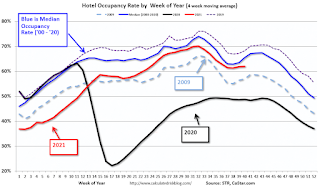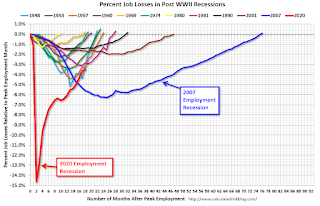by Calculated Risk on 10/07/2021 08:26:00 PM
Thursday, October 07, 2021
Friday: Employment Report
My August Employment Preview
Goldman September Payrolls Preview
Friday:
• At 8:30 AM, Employment Report for September. The consensus is for 460 thousand jobs added, and for the unemployment rate to decrease to 5.1%.
Hotels: Occupancy Rate Down 9.2% Compared to Same Week in 2019
by Calculated Risk on 10/07/2021 04:16:00 PM
Note: Since occupancy declined sharply at the onset of the pandemic, CoStar is comparing to 2019.
U.S. hotel performance dipped from the previous week, according to STR‘s latest data through Oct. 2.The following graph shows the seasonal pattern for the hotel occupancy rate using the four week average.
26 September through 2 October 2021 (percentage change from comparable week in 2019*):
• Occupancy: 61.7% (-9.2%)
• Average daily rate (ADR): US$130.87 (+1.2%)
• Revenue per available room (RevPAR): US$80.78 (-8.2%)
*Due to the steep, pandemic-driven performance declines of 2020, STR is measuring recovery against comparable time periods from 2019.
emphasis added
 Click on graph for larger image.
Click on graph for larger image.The red line is for 2021, black is 2020, blue is the median, dashed purple is 2019, and dashed light blue is for 2009 (the worst year on record for hotels prior to 2020).
Goldman September Payrolls Preview
by Calculated Risk on 10/07/2021 04:07:00 PM
A few brief excerpts from a note by Goldman Sachs economist Spencer Hill:
We estimate nonfarm payrolls rose 600k in September ... we believe the nationwide expiration of enhanced unemployment benefits on September 5 boosted effective labor supply and job growth ... We are assuming a 200k boost in tomorrow’s numbers and a larger boost in October. We also believe the reopening of schools contributed to September job growth, by around 150k. ... We estimate a one-tenth drop in the unemployment rate to 5.1%CR Note: The consensus is for 460 thousand jobs added, and for the unemployment rate to decrease to 5.1%.
emphasis added
October 7th COVID-19: Progress
by Calculated Risk on 10/07/2021 03:23:00 PM
| COVID Metrics | ||||
|---|---|---|---|---|
| Today | Week Ago | Goal | ||
| Percent fully Vaccinated | 56.2% | 55.6% | ≥70.0%1 | |
| Fully Vaccinated (millions) | 186.6 | 184.6 | ≥2321 | |
| New Cases per Day3 | 95,448 | 107,953 | ≤5,0002 | |
| Hospitalized3 | 63,921 | 74,091 | ≤3,0002 | |
| Deaths per Day3 | 1,431 | 1,562 | ≤502 | |
| 1 Minimum to achieve "herd immunity" (estimated between 70% and 85%). 2my goals to stop daily posts, 37 day average for Cases, Currently Hospitalized, and Deaths 🚩 Increasing 7 day average week-over-week for Cases, Hospitalized, and Deaths ✅ Goal met. | ||||
IMPORTANT: For "herd immunity" most experts believe we need 70% to 85% of the total population fully vaccinated (or already had COVID).
The following 22 states have between 50% and 59.9% fully vaccinated: Colorado at 59.9%, California, Minnesota, Hawaii, Pennsylvania, Delaware, Florida, Wisconsin, Texas, Nebraska, Iowa, Illinois, Michigan, Kentucky, South Dakota, Arizona, Kansas, Nevada, Alaska, Utah, North Carolina and Ohio at 50.7%.
Next up (total population, fully vaccinated according to CDC) are Montana at 48.9%, Indiana at 48.8%, Missouri at 48.4% and Oklahoma at 48.2%.
 Click on graph for larger image.
Click on graph for larger image.This graph shows the daily (columns) and 7 day average (line) of positive tests reported.
Homebuilder Comments in September: “Supply chain, supply chain, supply chain."
by Calculated Risk on 10/07/2021 01:29:00 PM
Today, in the Newsletter: Homebuilder Comments in September: “Supply chain, supply chain, supply chain."
Excerpt:
Some homebuilder comments courtesy of Rick Palacios Jr., Director of Research at John Burns Real Estate Consulting (a must follow for housing on twitter!):
"Just published September home builder survey results (sales, prices, costs, communities, etc.). Big themes: 1) Supply chain, supply chain, supply chain. 2) Monthly price hikes no longer the norm. 3) Some of the hottest markets sounding toppy. Market commentary to follow…"
September Employment Preview
by Calculated Risk on 10/07/2021 11:38:00 AM
On Friday at 8:30 AM ET, the BLS will release the employment report for September. The consensus is for 460 thousand jobs added, and for the unemployment rate to decrease to 5.1%.
 Click on graph for larger image.
Click on graph for larger image.• First, currently there are still about 5.3 million fewer jobs than in February 2020 (before the pandemic).
This graph shows the job losses from the start of the employment recession, in percentage terms.
The current employment recession was by far the worst recession since WWII in percentage terms, but is now better than the worst of the "Great Recession".
• ADP Report: The ADP employment report showed a gain of 568,000 private sector jobs, above the consensus estimate of 430,000 jobs added. The ADP report hasn't been very useful in predicting the BLS report, but this suggests the BLS report could be above expectations.
• ISM Surveys: Note that the ISM services are diffusion indexes based on the number of firms hiring (not the number of hires). The ISM® manufacturing employment index increased in September to 50.2%, up from 49.0% last month. This would suggest a decline in manufacturing employment of around 20,000 jobs in September. ADP showed 49,000 manufacturing jobs added.
The ISM® Services employment index decreased in September to 53.0%, down from 53.7% last month. This would suggest an increase in service employment of around 150,000 jobs in September.
Combined, the ISM indexes suggest a weaker than expected employment report.
• Unemployment Claims: The weekly claims report showed little change in the number of initial unemployment claims during the reference week (includes the 12th of the month) from 349,000 in August to 351,000 in September. This would usually suggest about the same number of layoffs in September as in August, although this might not be very useful right now. In general, weekly claims have been above expectations in September.
 • Permanent Job Losers: Something to watch in the employment report will be "Permanent job losers". While there has been a strong bounce back in total employment, from the shutdown in March and April 2020, permanent job losers hasn't increased as sharply.
• Permanent Job Losers: Something to watch in the employment report will be "Permanent job losers". While there has been a strong bounce back in total employment, from the shutdown in March and April 2020, permanent job losers hasn't increased as sharply.This graph shows permanent job losers as a percent of the pre-recession peak in employment through the June report.
This data is only available back to 1994, so there is only data for three recessions. In August, the number of permanent job losers decreased to 2.487 million from 2.930 million in July. These jobs will likely be the hardest to recover.
• IMPORTANT: Usually in September, about 1.2 million educators are hired as the school year starts in some areas. This is seasonally adjusted to around 0 (since it is expected). It is unclear if that many will be hired this year - or more (making up for low hiring), or less (due to the ongoing pandemic). This could distort the headline number.
• Conclusion: The data is mixed for September. However, the consensus is fairly low.
Weekly Initial Unemployment Claims Decrease to 326,000
by Calculated Risk on 10/07/2021 08:35:00 AM
The DOL reported:
In the week ending October 2, the advance figure for seasonally adjusted initial claims was 326,000, a decrease of 38,000 from the previous week's revised level. The previous week's level was revised up by 2,000 from 362,000 to 364,000. The 4-week moving average was 344,000, an increase of 3,500 from the previous week's revised average. The previous week's average was revised up by 500 from 340,000 to 340,500.The following graph shows the 4-week moving average of weekly claims since 1971.
emphasis added
 Click on graph for larger image.
Click on graph for larger image.The dashed line on the graph is the current 4-week average. The four-week average of weekly unemployment claims increased to 344,000.
The previous week was revised up.
Regular state continued claims decreased to 2,714,000 (SA) from 2,811,000 (SA) the previous week.
Note (released with a 2 week delay): There were an additional 647,690 receiving Pandemic Unemployment Assistance (PUA) that decreased from 1,059,248 the previous week (there are questions about these numbers). This was a special program for business owners, self-employed, independent contractors or gig workers not receiving other unemployment insurance. And threre were an additional 630,814 receiving Pandemic Emergency Unemployment Compensation (PEUC) down from 991,813.
Weekly claims were lower than the consensus forecast.
Wednesday, October 06, 2021
Thursday: Unemployment Claims
by Calculated Risk on 10/06/2021 08:00:00 PM
Thursday:
• At 8:30 AM ET, The initial weekly unemployment claims report will be released. The consensus is for 345 thousand initial claims, down from 362 thousand last week.
October 6th COVID-19: Slow Progress
by Calculated Risk on 10/06/2021 05:12:00 PM
| COVID Metrics | ||||
|---|---|---|---|---|
| Today | Week Ago | Goal | ||
| Percent fully Vaccinated | 56.1% | 55.9% | ≥70.0%1 | |
| Fully Vaccinated (millions) | 186.4 | 185.5 | ≥2321 | |
| New Cases per Day3 | 96,757 | 109,273 | ≤5,0002 | |
| Hospitalized3 | 65,162 | 75,426 | ≤3,0002 | |
| Deaths per Day3 | 1,428 | 1,488 | ≤502 | |
| 1 Minimum to achieve "herd immunity" (estimated between 70% and 85%). 2my goals to stop daily posts, 37 day average for Cases, Currently Hospitalized, and Deaths 🚩 Increasing 7 day average week-over-week for Cases, Hospitalized, and Deaths ✅ Goal met. | ||||
IMPORTANT: For "herd immunity" most experts believe we need 70% to 85% of the total population fully vaccinated (or already had COVID).
The following 22 states have between 50% and 59.9% fully vaccinated: Colorado at 59.8%, California, Minnesota, Hawaii, Pennsylvania, Delaware, Florida, Wisconsin, Texas, Nebraska, Iowa, Illinois, Michigan, Kentucky, South Dakota, Arizona, Kansas, Nevada, Alaska, Utah, North Carolina and Ohio at 50.6%.
Next up (total population, fully vaccinated according to CDC) are Montana at 48.8%, Indiana at 48.7%, Missouri at 48.4% and Oklahoma at 48.1%.
 Click on graph for larger image.
Click on graph for larger image.This graph shows the daily (columns) and 7 day average (line) of positive tests reported.
1st Look at Local Housing Markets in September; Denver, Las Vegas and San Diego
by Calculated Risk on 10/06/2021 11:33:00 AM
Today, in the Newsletter: 1st Look at Local Housing Markets in September
Excerpt:
Here is a summary of active listings for these housing markets in September. Inventory was down 1.0% in September MoM from August, and down 36.6% YoY.
Inventory in San Diego is at an all time low, whereas inventory in Denver is up 107% (about double) from the all time low in March of this year. Las Vegas inventory is up 74% from the record low in April. Most markets have seen active inventory increase from earlier this year, but San Diego and Miami are plumbing new lows.



